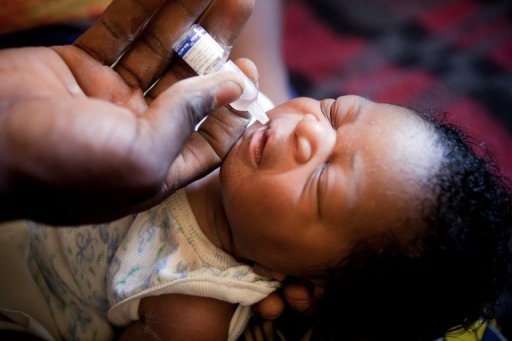– Acute viral infection due to a poliovirus (serotypes 1, 2 and 3). The transmission is direct (faecal-oral) or indirect (ingestion of water or food contaminated with feces). Man is the only reservoir of the virus. In principle, the disease can be eradicated by mass vaccination with oral polio vaccine (OPV).
– In endemic areas, outbreaks mainly affecting children under 5 years. In non-endemic area where immunization coverage is low, young adults are most commonly affected.
 Clinical signs:
Clinical signs:
– In over 90% of cases the infection is asymptomatic.
– Form non paralytic, non-specific febrile illness with muscle aches, headache, vomiting, back pain; without neurological signs.
The diagnosis is rarely made outside an epidemic all that evolution is generally carried out to spontaneous healing in ten days.
– Paralytic form: in less than 1% of cases, after these non-specific signs, the patient develops acute flaccid paralysis, asymmetric, quick installation (after waking up), predominant in the lower limbs, with upward extension.
The muscles are soft with diminished reflexes. Sensitivity is retained.
The prognosis is at stake when the paralysis affecting the respiratory muscles or swallowing. Urinary retention is frequent in the beginning. Digestive disorders (nausea, vomiting, diarrhea), myalgia, meningeal irritation may be associated.
Laboratory:
Search poliovirus in the stool. The virus is shed for a month after infection, but intermittently. This is why two samples must be collected 48 hours apart.
Treatment:
– Admit forms paralytic: rest, prevention of bedsores in bedridden patients, analgesics (not to IM injection during the febrile phase), assisted ventilation if respiratory paralysis.
– Functional rehabilitation as soon stabilize lesions to prevent muscle atrophy and contractures.
– Supports sequelae: physiotherapy, surgery and equipment.
What to do before a case of acute flaccid paralysis (AFP):
– Consider all AFP cases as polio suspicion.
– Confirm the diagnosis by isolating the virus: contact the reference laboratory the two stool samples together with a clinical description of the disease.
The stool should be stored and transported between 0 ° C and 8 ° C.
– Pending confirmation, vaccinate all children under 5 living in the vicinity (the same village, the neighboring villages), regardless of their vaccination status.
– Upon confirmation of the event, organize a mass vaccination campaign: the extent and the age range is determined based on epidemiological data.
– Surveillance: for every case of AFP, there 100 to 200 sub-clinical cases. Active surveillance for new cases is essential to control outbreaks.
Prevention:
– There are 2 types of vaccine:
• injectable inactivated vaccine (IPV)
• an oral live attenuated trivalent vaccine (OPV).
In developing countries and in the context of the polio eradication campaigns, the oral vaccine is recommended for reasons of cost, ease of administration, but especially because of its epidemiological qualities: it gives a quick intestinal immunity (epidemic ) and group protection with its secondary distribution in the environment.
– Vaccination scheme (OPV)
WHO recommends four doses before the age of one year:
* If the first dose (OPV-0) was not given at birth, the fourth dose given at least one month after the third dose, at the same time as measles, for example.
